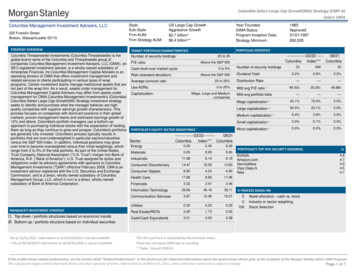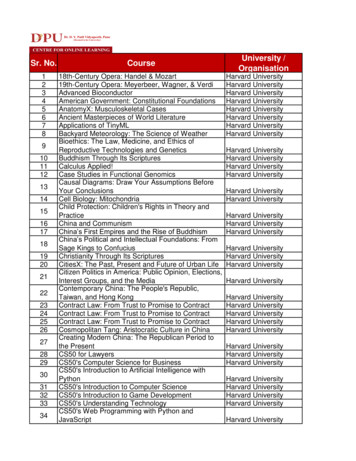
Transcription
RAPID Language Reference ManualBen Edelstein, Brian Shin, Brendon Fish, Dan Schlosser, Nate Brennand1
Table of ContentsRAPID Language Reference Manual1. Introduction1.1 Why RAPID?1.2 RAPID Programs2. Types2.1 Static Typing2.2 Primitive TypesnullBooleansIntegersFloating Point NumbersStrings2.3 Non-Primitive ned ResponsesFunctions2.4 CastingIntegers and FloatsBooleans3. Lexical Conventions3.1 Identifiers3.2 Keywords3.3 LiteralsInteger literalsFloat literalsString literalsBoolean literalsList literalsDictionary literals3.4 Comments3.5 Operators4. Database Backing2
4.1 ClassesInstance MethodsInstantiation4.2 Deletionjson4.3 Querying5. Functions5.1 Declaration5.2 Unsafe Functions6. Routing6.1 Declaring Routes6.2 Path contextClassesNamespacesParameters7. Syntax7.1 Program Structure7.2 ExpressionsConstantsIdentifiersBinary OperatorsParenthesized Expressions7.3 StatementsAssignmentsDeclarationsVariable DeclarationFunction DeclarationRoute DeclarationClass DeclarationNamespace or Parameter DeclarationFunction callControl flowIfIf-elseElse-ifSwitchWhile loopsFor loopsReturn statements3
8. Built-in Functions8.1 length()8.2 range()8.3 Output FunctionsPrint Functions8.4 Logging Functions9. Standard Library9.1 stringstring.is empty()string.substring()Get (c string[i])Set (string[i] s)Iterate (c in string)Slice (string[i:j])9.2 listlist.is at()list.reverse()list.copy()Get (list[i])Set (list[i] j)Iterate (j in list)Slice (list[i:j])9.3 dictdict.is empty()dict.has ues()Get (dict[k])Set (dict[k] v)Iterate (j in dict)9.4 errorerror.messageerror.codeerror.name10. Program Execution4
10.1 Flags5
1. IntroductionWith increased demand in the public and private sector for cloud-connected mobile and web applications hascome a rising need for web servers to maintain state across multiple devices and users. Development of webservers is complex, however. Building a web server using modern web server packages requires learning aserver-side programming language, and then integrating a web server package and implementing requiredmethods. Furthermore, local testing and development of these servers is excessively complex, as they havenumerous dependencies and are difficult to build.RAPID is a programming language intended specifically for the rapid development of modern web APIs. UsingRAPID, developers can quickly build a database-backed REST API server that guarantees JSON shapes in responses.RAPID is object oriented and database-backed, meaning that classes represent an SQL table, and uponinstantiation objects are automatically saved in the database. This abstracts away much of the boiler plate codethat developers typically write when building an API server.1.1 Why RAPID?The name RAPID represents the goal of the language: making API server development quick. Also, it’s a recursiveacronym for RAPID Application Programmer Interface Dialect.1.2 RAPID ProgramsThere are two types of RAPID programs, servers and scripts. If a program contains an HTTP method, it is a server,otherwise it is a script. (See more in later sections).6
2. Types2.1 Static TypingRAPID is a statically typed language; variables must be explicitly typed upon declaration. Variables can be cast toother types (see Casting).2.2 Primitive TypesnullIn RAPID, the null keyword represents an uninitialized value. Any type in rapid may take on null if it hasn’tbeen initialized, or otherwise doesn’t exist.BooleansBoolean values are defined by the true and false keywords. Because they are their own type, non-booleanvalues must be cast to boolean in order to be used in logical expressions.For example:!(3 5)? // valid RAPID!(3 5) // not valid RAPIDThe ? is a an operator on all primitive types that evaluates to the “truthiness” of that value.IntegersIntegers are preceded by the type int , and represent an 8 byte, signed integer. Integers can be declared andinitialized later, or initialized inline. Uninitialized integers are null.int i// nullint i 5 // 5Integers are copied by value.7
int a 1int b aa 2printf("%d, %d", a, b) // 2 1Floating Point NumbersFloating point numbers are preceded by the type float , and represent IEEE-754 64-bit floating-point numbers.They can be declared and initialized later, or initialized inline.float i// nullfloat j 3.14 // 3.14StringsStrings in RAPID are mutable, and declared with the string type, and have the default value of the empty string.String literals are declared using double quotes, and special characters may be escaped using the \ character.Strings may be indexed using square brackets. Because there is no Character type in RAPID, single characters arestrings of length 1. Multiline strings may be declared using triple double quotes. Newlines are preserved and quotesdo not need to be escaped, but they may not be nested. Strings are pass by value.string sstring character "c"string s "He is \"Batman\""string c s[0]string multi """Did you hear?He calls himself "Batman"."""////////nullcHe called himself "Batman"H// multi[0] "\n"2.3 Non-Primitive TypesListThe list type is a zero-indexed array that expands to fit it’s contents. The type of the contents must be providedwithin angle brackets in the type signature. RAPID list literals may be declared using square brackets, and valuesmay be accessed or set using square brackets. Uninitialized lists default to the empty list. Lists are pass byreference.8
/* List declaration */list /* type */ /* id */ [/* expression */,/* expression */,./* expression */]list int empty // []list int numbers [1,2,3,42]numbers[3]// 42numbers[1] 5 // [1,5,3,42]DictionaryThe dict type is similar to an object, but it’s key set is mutable. The type of the key and value must be providedwithin angle brackets in the type signature. Only primitive types may be used as keys. Keys may be added, set, andaccessed using square brackets. RAPID dict literals may be declared as comma-separated key:value pairssurrounded by braces. Uninitialized dictionaries default to the empty dictionary. Dictionaries are pass by reference./* Dictionary declaration */dict /* type */ , /* type *//* expression:string */ :/* expression:string */ :./* expression:string */ :} /* id */ {/* expression */,/* expression */,/* expression */dict string, int empty // {}dict string, int ages {"Alice":3, "Bob":5}ages["Alice"]// 3ages["Bob"] 4// {"Alice":3, "Bob":4}ages["Caroline"] 7// {"Alice":3, "Bob":4, "Caroline":7}ObjectThe object type is a generic, non-primitive, dictionary-backed type that has attributes for instance variables andfunctions. Accessing instance variables or functions can be done with dot notation. Objects may not be declaredanonymously; they must be declared as instances of classes. Objects have immutable key sets, so variables andfunctions may not be added or removed, although their values may be changed. For more on classes andinstantiation, see Classes.9
jsonThe json type is shares qualities of a dictionary and of an Object. Every json type is directly connected to anObject class that is user-defined. They have keys and values like dictionaries, but have the strict requirements ofshape like objects do. Every property of a class is a mandatory key on the corresponding json object, andproperties that have default values on objects have default values in json . Unlike objects, however, json objectsdo not have methods associated with them, and instances do not represent rows in the database. Each classdeclaration defines an Object type and a json object type, and only json objects that are associated withclasses may be instantiated.For example, if we previously defined a User object with three instance variables username , full name , andpassword (all strings), then we may declare a json User like so:/* JSON Object initialization */json /* id:classname */ /* id */ json /* id:classname */ (key /* expression */,key /* expression */,.key /* expression */)json User steve json User (username "sedwards",full name "Stephen Edwards",password "easypeasy")ErrorsErrors in RAPID are not thrown and caught, rather they are returned directly by unsafe functions (see Functions).Errors contain a string message, which can be dot-accessed, an integer error code that conforms with the HTTP/1.1standard, and an optional string name.For example, to declare a custom error:error e error(message "There was an error with that Request.",code 400,name "RequestError")Unsafe operations return an error as the last return value:dict string, int d {"foo": 4, "bar": 5}10
int val, error e if (!e?) "]e.code)// 500e.message) // Key error when accessing "baz" on d .e.name)// KeyErrorMany standard library classes and builtin objects define errors pertinent to their functions, to which an errorinstance may be compared.dict string, int d {"foo": 4, "bar": 5}int val, error e d["baz"]if (!e?) {printf("%s", e dict.KeyError) // true}StackingUnsafe functions (like list and dictionary access) may exist in the same expression. If unsafe functions returnsuccessfully, the error that is returned is consumed (ignored), and the return value is taken. If an unsafe functionreturns an error, the expression evaluation short-circuits, and the value of the expression is null and the error that isreturned by the failed function call.dict string, list int d {"foo": [4,5], "bar": [1,2,3]}int val, error e d["foo"][2]// List index out of bounds.printf("%d", val)// nullprintf("%s", e.name)// IndexErrorprintf("%t", e list.IndexError) // trueval, e d["baz"][0]printf("%d", val)printf("%s", e.name)printf("%t", e dict.KeyError)////////No such key, short circuitnullKeyErrortrueMore generally, if a subexpression of an expression is unsafe, it is presumed to be successful and the return value ofthe subexpression is used in the evaluation of the larger expression, unless the unsafe expression evaluates to anerror, in which case evaluation of the large expression short-circuits, and the value of the large expression isnull, /* sub-expression's error */ .Predefined ResponsesUnsafe functions may also choose to return an predefined response, which is an predefined literal that will be castto a generic error object at compile time.See Functions for more details.All predefined errors exist in the root scope and are named according to their status code, e code .11
e404 is the error, error("Not Found", 404, "NotFound") (message, code, name).All the below errors are predefined as ee200OK200OKe201Created201Createde301Moved 4Not Modified304NotModifiede400Bad de403Forbidden403Forbiddene404Not Found404NotFounde405Method Not st Entity Too Large413RequestEntityTooLargee414Request-URI Too Long414RequestURITooLonge417Expectation Failed417ExpectationFailede500Internal Server Error500InternalServerErrore501Not Implemented501NotImplementede502Bad Gateway502BadGatewaye503Service Unavailable503ServiceUnavailablee504Gateway Timeout504GatewayTimeoutFunctionsFunctions are first class objects, and may be passed around as variables (see Functions)12
2.4 CastingIntegers and FloatsCasting between float and int can be done using the float() and int() keyword functions. Floats are flooredwhen they are cast to int. Additionally, integers are cast to floats if floats and integers are used together in a binaryoperator.floatint ifloatint if f 7.53 float(i) // f 3.0int(f)// i 7BooleansAny value may be cast to boolean using the ? operator.See the following table for the result of using the ? operator on various types:TypefalseCommentstrue?false?Booleans retain their value1? , -1?0?float1.0? , -1.0?0.0?0.0 is false , other floats are truenull-null?null is falselist[0]? , [false]?[]?Empty lists are falsedict{"key":false}?{}?Empty dicts are falsejsonjson Obj ()?-JSON objects are trueObj()?-Objects are truebooleanintobjecttrue0 is false , other ints are true13
3. Lexical Conventions3.1 IdentifiersIdentifiers must start with a letter or an underscore, followed by any combination of letters, numbers, andunderscores.Valid Identifiers:abc , abc def , a 1 , a , 1 , ABCInvalid Identifiers:123 , abc-def , 1abc , ab\ cd3.2 KeywordsThe following identifiers are keywords in RAPID, and are reserved. They can not be used for any other purpose.if , else , for , in , while , switch , case , default , fallthrough , http , func , json , class ,namespace , param , true , false , new , optional , unsafe , instance3.3 LiteralsInteger literalsInteger literals may be declared using digits.int x 5Float literalsFloat literals are declared as an integer part, a decimal point, and a fraction part, all of which are mandatory. Theinteger part may not start with a zero, unless it is only a zero (for floats less than 1.0 ), in which case it is still14
required. There may not be any whitespace between these three parts.// Valid float literals:float x 15.0float y 0.25// Invalid float literals:float z .5float w 10.float v 1 . 4String literalsString literals are declared using double quotes. Special characters may be declared using the \ escape character.string a "hello"string b " \"world\"\n"Boolean literalsBoolean literals are declared using the true and false keywords.boolean t trueboolean f falseList literalsList literals may be declared between square brackets, with comma-separated values.list int a [1,2,3,4]list string b ["hello", "world"]Dictionary literalsDictionary literals may be declared as comma-separated key value pairs between braces, with a colon separatingthe key and value. Whitespace is ignored.dict string, int a {"hello": 4, "world": 5}dict string, ing b {15
"a": 42,"b": 27}3.4 CommentsThere are two types of comments in RAPID: single line comments, and block comments. Single line comments arepreceded by // and block comments begin with /* and end with */// This is a single line comment/*This is a multi-linecomment/* They may be nested */*/3.5 OperatorsOperatorUseAssociativity actionleft%Modulusleft Assignmentnon-associative Equal tonon-associative! Not equal tonon-associative Greater thannon-associative Less thannon-associativeGreater than or equal tonon-associative 16
Operator UseAssociativityLess than or equal tonon-associative17
4. Database Backing4.1 ClassesRAPID classes are backed by a PostgreSQL database.Classes are defined using the class keyword, and represent an SQL table.Instance variables (variables declared directly within the class block) represent columns for the table.Instances of a class represent rows in SQL.By default, columns are not nullable, but this may be overwritten using the optional keyword.If the assignment syntax is used, a default value will be given.class /* id */ {/* declaration *//* declaration */./* declaration */}Take the following example:class User {string usernameoptional string full nameint age 18string password}In this example, the “User” table has four columns: username , full name , age , and password . Thefull name column may be omitted in the instantiation, and if age is omitted, it will take the value 18 .Instance MethodsInstances of objects may have methods that operate on their instances variables. Using the instance keyword, ablock may be created in which instance methods may be defined:class /* id:classname */ {instance /* id:selfname */ {/* declaration *//* declaration */./* declaration */18
}}The identifier specified after the instance keyword will represent the instance in all functions defined inside theinstance block.Instance methods may not be http routes. The . is syntactic sugar for calling instance methods.For example:class User {string first namestring last nameinstance my {func get full name() string {return my.first name " " my.last name}}}User obama User(first name "Barrak", last name "Obama")printf("%s", obama.get full name()) // Barrak ObamaInstantiationNew instances of a class may be declared using the new keyword.The new keyword is followed by the name of the class and a pair of parenthesis, in which a JSON User literal(described more in-depth in the next section) may be passed to declare instance variables.Once a user defined object is created, it will be database backed.Any changes to the object will trigger an update to the database backed copy.Every object will have an ID attribute generated (this is a reserved attribute that cannot be used).This is a unique identifier to the object.User bob new User(username "burgerbob",full name "Bob Belcher",password "burgersrock",age 42)4.2 Deletion19
All objects have an instance method, delete() , defined that will delete the database record.There is no return value for the delete call.jsonDefining the “User” class defines a User type, as well as a json User type. The json User type has thesame keys and value types as the User class, and may be declared in dictionary literal syntax.json User bob json json User (username "burgerbob",full name "Bob Belcher",password "burgersrock",age 42)This json User object does not represent a row in the database, and will be deallocated when it leaves scope.It may be passed into an instantiation statement for a User object, to be persisted:User bob, error e new User(bob json)4.3 QueryingObjects may be queried from the database using the get function, which is automatically defined on all classes.get is an unsafe function which will return a list of objects as well as an error.The following example queries all User objects from the database:Tweet[] tweets Tweet.get()A optional filter parameter can be set to limit the responses returned by Get().The filter value shoudld be a dictionary of attributes and values.Any non-existant attributes in the dictionary will be logged as an warning and ignored.// returns all tweets by burgerbob.Tweet[] tweets, error e Tweet.get(filter {username "burgerbob"})A optional ID parameter can be set to return a single Object.This can be combined with filter if desired.20
In the case that the object is not found, the returned object will be null and the error will be a non-null value.// returns all tweets by burgerbob.Tweet t, error e Tweet.get(ID "123abc")21
5. Functions5.1 DeclarationFunctions in RAPID are first-class objects, but may not be declared anonymously. Functions are declared using thefunc keyword. The arguments (within parenthesis), return type (after the parenthesis, but before the braces), andthe body of the function (within the braces) must be declared explicitly. Return types may include multiple typesseparated by commas, or may be omitted for void functions.Return values are specified using the return keyword, which must be followed by an expression to be returnedfor functions that have declared return types. If the return type is omitted, the function is void, an the result ofcalling it may not be assigned to a value. Void functions may use the return keyword by itself to exit prematurelyfrom the function.Unsafe functions may not be void, because they must return errors.return /* expression */The arguments must be in order namespace arguments, then formal arguments.[unsafe] func /* id */ ( /* namespace args */ /* formal args */ ) {// statements}For example:func sum(int a, int b) int {return a b}Or:func printInt(int a) {printf("%d", a)}5.2 Unsafe FunctionsIf a function performs actions that may be unsafe, it must be preceded by the keyword unsafe . Unsafe functions22
return unsafe expressions, which is denoted by the presence of an error -typed second value that is returned.unsafe func access(dict string, int d, string key) int {int val, error error d[key]return val, error}Notice that the return type remains int , although an error is also returned. For more on unsafe expressions, seeExpressions.Unsafe functions may also return a error, which are integer literals that will be cast to a generic error object atcompile time. See Status Code Definitions for a complete list of error codes that may be declared as anonymouserrors./* Default dict accessing:*If there is a KeyError, return 0 with a 400 Not Found error*/unsafe func access(dict string, int d, string key) int {int val, error error d[key]if (error dict.KeyError) {return 0, e400}return val, e200}23
6. RoutingOne of the core features of RAPID is it’s ability to easily define routes for a REST API server.6.1 Declaring RoutesRoutes may be declared like functions, but substituting the http keyword for the func keyword. Routes specifya REST API endpoint, it’s parameters, it’s response, and any side effects.Like functions, routes take namespace arguments, and then other formal arguments. Unlike functions, however,routes may also take a single request body argument that of a json Obj type. It will be read from the requestbody and interpreted as JSON.http /* id */ ( /* namespace args */ /* formal args */ /* request body args */) {// statements}Routes are unsafe by default, and therefore must include error in their return types. This may be an anonymouserror (see Functions).For example, the following route echos the URL parameter that it is passed.http echo(string foo) string, error {return foo, e200}The name of the function will be the name of the route. Therefore, in the preceding example, a GET request to/echo?foo Dog will return "Dog" .6.2 Path contextThe endpoint associated with each route is determined by the combination of one or more blocks associated withit and the name of the route itself. There is a one-to-one mapping from any route to a series of accessors on classinstances.ClassesClasses provide path context. Class names are put to lowercase, and appended to path context. The following24
example defines a route named add inside a class called Math .class Math {http add(int a, int b) int {return a b, e200}}A GET request to /math/add?a 3&b 4 will return 7 .Similarly, the following code will print 7 :math Math()int sum, error math.add(3,4)printf("%d", sum)NamespacesSometimes, functions or routes should be grouped together for organization purposes, rather than any functionalpurpose. The namespace keyword defines a named block of functions that has the namespace name appended tothe path context for those functions./* Namespace declaration */namespace /* id */ {// statements}class Math {namespace ops {http add(int a, int b) int { return a b, e200 }http sub(int a, int b) int { return a - b, e200 }}namespace convert {func ft to in(float feet) float { return feet*12, e200 }}}This defines routes at /math/ops/add andMath.ops.sub , and Math.convert.ft to in ./math/ops/sub ,and functions atMath.ops.add ,A GET request to /math/ops/add?a 3&b 4 will return 7 .Parameters25
Variable URL parameters may be defined similar to namespaces, using a named block with the param keyword.The param keyword is followed by a type and an identifier.Any function or route defined within a param block must take the parameters defined by the param blocks inorder from inside to out.param /* type */ /* id */ {// statements}For example:class Math {param int a {param int b {http add(int a, int b) int { return a b, e200 }}http square(int a) int { return a*a, e200 }}}A GET request to /math/5/7/add will return 12 , and a GET request to /math/5/square will return 25 . AGET request to /math/5/7/add?a 4 will return return a 400 HTTP error. The following code snipped will print12 then 25 :math Math()int sum, error math.add(5,7)printf("%d", sum)int sqr, error math.square(5)printf("%d", sqr)26
7. Syntax7.1 Program StructureA valid RAPID program is a series of valid statements. If the program contains any http blocks, it will beinterpreted as a restful web API, and will run a HTTP web server on localhost:5000 .7.2 ExpressionsExpressions are series of operators and operands that may be evaluated to a value and type. Any subexpressionsare evaluated from left to right, and side effects of evaluations occur by the time the evaluation is complete. Typechecking on operations occur in compile time.ConstantsConstants may be string, integer, float, or boolean, dict, list, or JSON object literals. See Lexical Conventions formore information.IdentifiersIdentifiers could be primitive types, lists, dictionaries, objects, JSON objects, functions, classes, or errors. Identifierscan be modified, and reused throughout a program.For example, in the following example, the variable a changes value three times.class a {} // a is a classfunc a() void {} // is a function, the class no longer exists.int a 5 // is an int, the function no longer exists.Identifiers are tied to the scope that they are declared in. The following example prints 3 , then 5 , then 3 :int a 3if (true) {printf("%d", a) // a is from the parent scope.int a 5printf("%d", a) // a is from the local scope.}27
printf("%d", a) // the a from within the block does not leave itBinary OperatorsBinary operators have two operands, one on the left side, and one on the right./* expression */ /* bin-op */ /* expression */In the case of multiple consecutive binary operations without parenthesis, the association of the binary operator isfollowed (see Operators).Parenthesized ExpressionsParenthesis may be used to alter the order of operand evaluation.7.3 StatementsAssignmentsAssignments have an lvalue , and an expression, separated by an equal sign. Possible lvalue s includeidentifiers, accessors (either list, dict, or object), a declaration, or another assignment:/* lvalue */ /* expression */Examples include:a intj k bi 7square(i)5 * bDeclarationsA declaration may be the declaration of a variable, an assignment, or the declaration of a function, route, class,namespace, or param.Variable Declaration28
A variable declaration consists of a type and an id./* type */ /* id */Function DeclarationThe declaration of a function is a valid statement (see Functions).Route DeclarationThe declaration of a class is a valid statement (see Routing).Class DeclarationThe declaration of a class is a valid statement (see Classes).Namespace or Parameter DeclarationThe declaration of a namespace or parameter is a valid statement (see Path Context).Function callA function call is an identifier of a declared function and a set of parenthesis containing the comma-separatedarguments. There may not be a space between the identifier and the open parenthesis.my func(4,5)int x add(2, 6, 7)Control flowIfIf the expression between the parenthesis of an if statement evaluates to true , then the statements within thebody are executed. Note that non-boolean values will not be cast to boolean, and will result in a compile-time error.if (/* expression */) { /* statements */ }If-elseAn if statement may be immediately followed by an else statement, in which case the block of code within the29
braces after the else keyword will be executed if the if ’s expression evaluates to false .if (/* expression */) {// statements}else {// statements}Else-ifAn if statement may be followed by an else if statement, in which case the the second if statement will beevaluated if and only if the first if statement evaluates to false . The body of the else if is executed if thesecond if statement is evaluated, and evaluates to true . An else if statement may be followed by anotherelse if statement, or an else statement.if (/* expression */) {// statements}else if (/* expression */) {// statements}.else if (/* expression */ ) {// statements}else {// statements}SwitchA switch statement includes an expression, which is evaluated and then compared in order to a series of one ormore case expressions. If the expressions are equal, the body of the case statement that matches will beexecuted, and then the switch statement will short circuit. The fallthrough keyword may be used to avoid thisshort circuit, continuing to compare the switch expression with subsequent case expressions.The default statement may be included after all case statements, and will be executed if it is reached. This canbe thought of as a case whose expression always equals that of the switch . Observe the syntax below:switch (/* expression */) {case (/* expression */) {// statementsfallthrough}30
case (/* expression */) {// statements}default {// statements}}While loopsWhile loops contain an expression and a body. If the expression evaluates to true , the body will be executed.Afterwards, the expression will be evaluated again, and the process repeats. Like if statements, whilestatements must have expressions that evaluate to a boolean in order to compile.while (/* expression */) {// statements}For loopsA for loop may be used to iterate over a list . The syntax is:for (/* type */ /* id */ in /* list expr */) {// statements}For example:list int my list [1,2,3,4,5]for (int num in my list) {printf("%d ", num)}// 1 2 3 4 5The range() function in the standard library may be used to generate lists of sequential integers.for (int num in range(1,6)) {printf("%d ", num)}// 1 2 3 4 5Return statements31
A return statement may be used to exit a function, optionally passing the value of an expression as the returnvalue of the function.return /* optional expression */For example:func int add(int x, int y) int {return x y}printf("%d", add(3,4))// 732
8. Built-in Functions8.1 length()funcfuncfuncfunclength(string s) intlength(list T l) intlength(dict T,S d) intlength(json T j) intReturns the length of the argument. For strings, this is the number of characters in the string, for lists, this is thenumber of elements in the list. For dicti
RAPID is a programming language intended specifically for the rapid development of modern web APIs. Using RAPID, developers can quickly build a database-backed REST API server that guarantees JSON shapes in responses. RAPID is object oriented and database-backed, meaning that classes represent an SQL table, and upon










